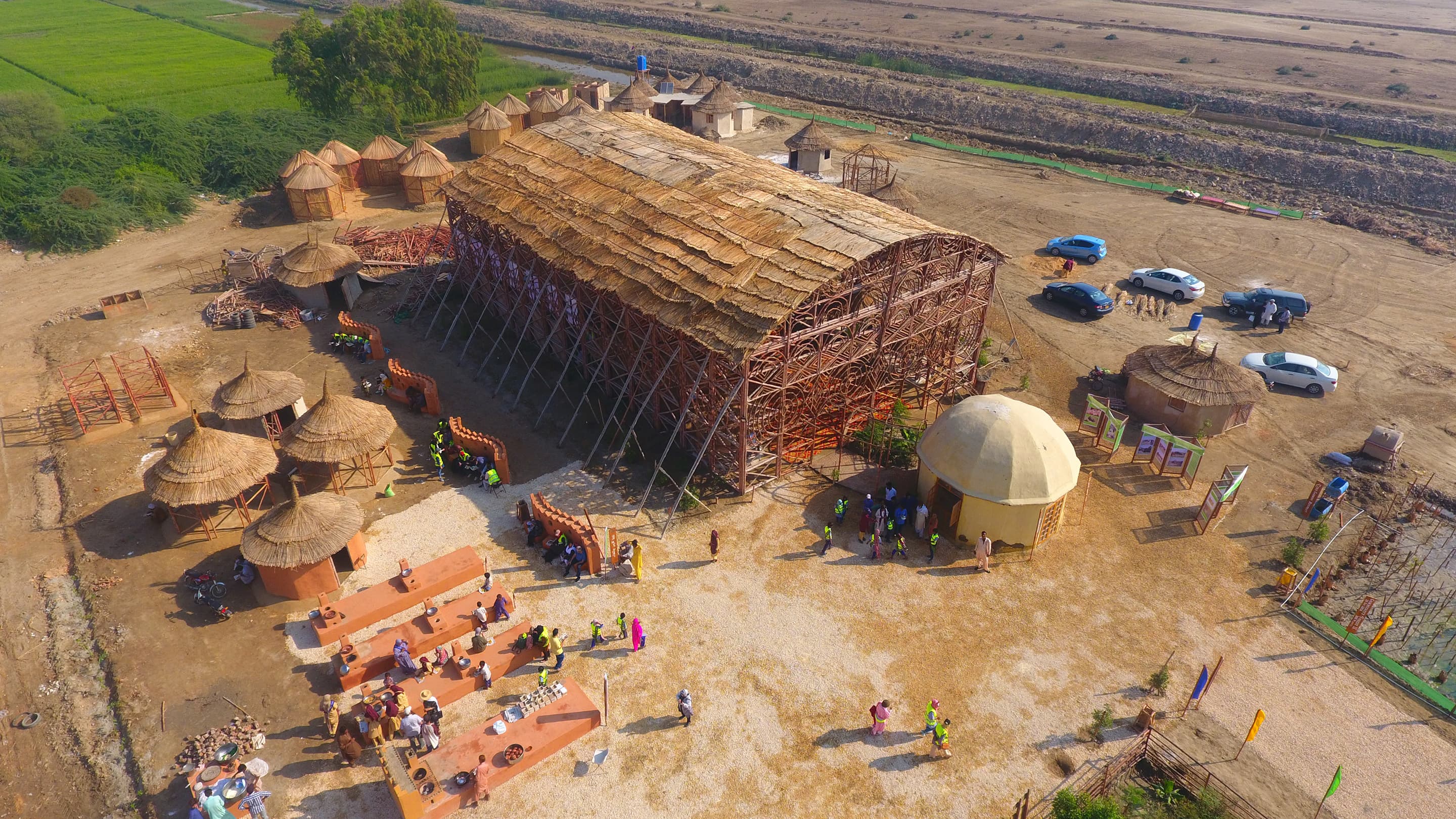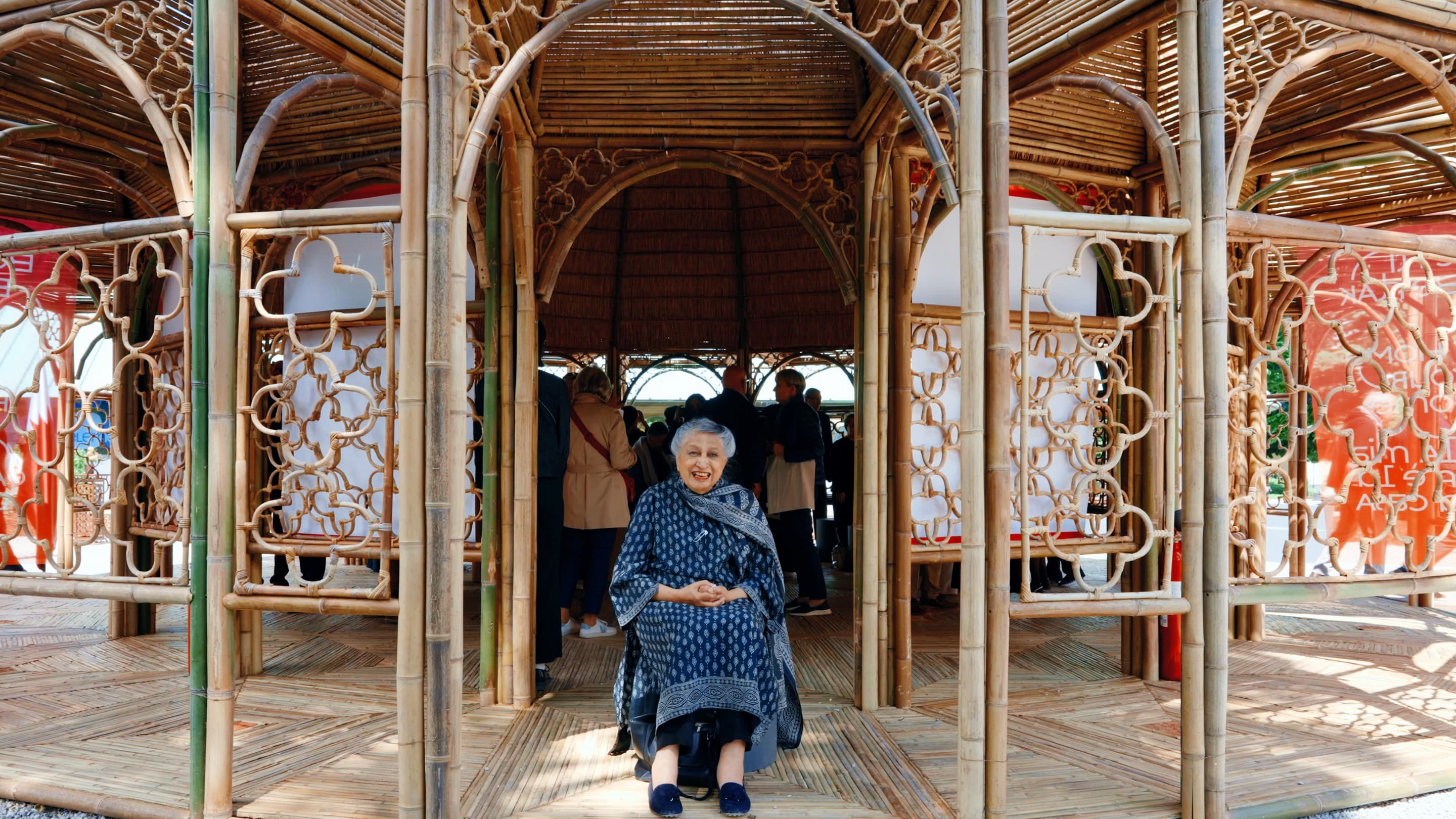
“Our entire understanding of the role of the architect must change” says Yasmeen Lari
After decades designing buildings for the elite, Pakistan’s first woman architect switched tracks and dedicated her practice to serving humanity. At the opening of the 2025 Venice Architecture Biennale, The World Around sat down with Yasmeen Lari to discuss her bamboo installation for the Qatar National Pavilion, the importance of bringing vernacular architecture to the international stage, and the urgent responsibilities of the architect today.
By Satomi Blair
Satomi Blair: We’re sitting in your Community Center, which is on the site of the future permanent Qatar National Pavilion. Tell me about its journey to Venice.
Yasmeen Lari: We were first asked to prefabricate this bamboo structure, which I really designed for the poor in my country, for an exhibition in Doha [MANZAR: Art and Architecture from Pakistan 1940s to Today at the National Museum of Qatar] and then Her Excellency, the Sheikha [Al Mayassa bint Hamad bin Khalifa Al Thani, commissioner of the Qatar Pavilion] decided to bring it to Venice for the Biennale.
SB: The title of the Qatar Pavilion at this year’s Biennale is Beyti Beytak. My Home is Your Home. La mia casa è la tua casa—it’s rooted in the Arabic word “bayt,” meaning “home.” How does the Community Center speak to that theme?
YL: This title conveys the sense of hospitality that I think the whole of the Arab world is known for, that the whole of south Asia is known for. In a sense, the pavilion embodies that kind of welcoming gesture. It’s very open, it’s non-threatening to people and the planet, and people can walk in and out as they choose. I’m enjoying sitting here, because I can see people coming in and much to my surprise they seem to like it, even though it’s only bamboo. Laughs.
SB: It’s not a mainstream building material, no, but bamboo construction has become a mainstay of your own work. You said you really designed the pavilion for the poor people in Pakistan, your country. Tell me about how the pavilion fits into your wider approach to architecture.
YL: For the longest time, my motto has been zero carbon, zero waste, zero poverty. We have been so extractive in the way we’ve been building for years now and harmed the planet to no end. And as you probably know, many countries in the Global South are particularly suffering from the effects of climate change. So for the last 20 years now, ever since an earthquake hit my country in 2005, I've been engaged in this work trying to help the most vulnerable members of our society with as minimal carbon impact as possible. I do not design for the rich anymore: I only design for people who have been hit by calamity or who live below the poverty line.
But as a profession, I think architects need to be much more conscious of how we are collectively responding to these challenges. We know that there is an extremely large gap between the rich and the poor of the world today. We know that there’s what I call “ecological tyranny,” where urban areas are not being designed for human beings, but for vehicles. We see people suffering from the urban heat island effect and urban flooding. But as designers, we seem not to be there to help. I really feel that architects must change; I feel that our entire understanding of the role of the architect must change.
SB: And what role do you think architects should step into?
YL: I think we should become champions! I think we should be much more proactive, rather than just waiting for commissions to design something iconic for the richest in society. Because we are more aware than most other professions of our impact on the planet. We are the ones who know what’s happening with the environment. We are the ones who know how threatening the way we build can be to the planet. And unless we change and respond to the needs of today, I think our profession might become redundant. So we’ve got to change. We cannot abdicate our responsibility. We know now that this is the challenge: we’ve got to take it on.
SB: There’s an obvious environmental impact to putting on an international exhibition of this scale. What do you see as the value of participating in events like the Biennale?
YL: I have to compliment Qatar for being so forward-looking. In a place where so much innovation is on show, they have chosen to be represented by something very modest, even though they could have built something very expensive. But I think that even this modest structure conveys an important message: that there are architects working to heal the planet. So I’m all for it.
SB: What lessons do you want architects to take away from the Qatar Pavilion?
YL: I think that we should be looking more at alternative materials, not only bamboo, but others, too. Earth, for example, is incredible. The exhibition at the Palazzo Franchetti shows work from [Egyptian architect] Hassan Fathy, who was this great visionary who worked within communities and used a lot of clay, and many of the other architects included in the exhibition provide examples of self-building and more participatory ways of doing things. So I think much can be done if you turn to the past and look at the visionaries whose work was quite extraordinary for their times. I think the time has come for us to work with communities to see how we can help them have a better life, to support their well-being, more than to think about individual wealth. Of course, you need a basic amount of money to survive. And everybody should have that. But ultimately, the well-being of humanity is far more important than the balance on any one person’s bank account.
SB: Those are strong words.
YL: I hope they’re not too hard-hitting. But I think people have to wake up.
“We see people suffering from the urban heat island effect and urban flooding. But as designers, we seem not to be there to help. I really feel that architects must change; I feel that our entire understanding of the role of the architect must change.”
RELATED VIDEOS

Seeking Social and Ecological Justice for Humanity
